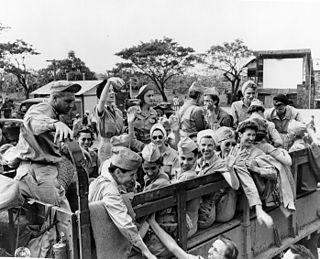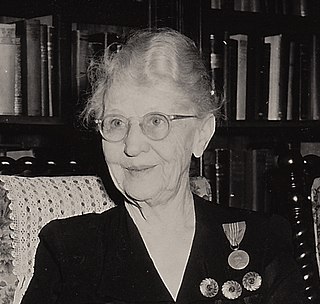
Pasay, officially the City of Pasay, is a 1st class highly urbanized city in the National Capital Region of the Philippines. According to the 2020 census, it has a population of 440,656 people.

Josefa Madamba Llanes Escoda was a Filipino civic leader, social worker, World War II heroine, and suffragette. She is most known for campaigning for women's suffrage and as a founder of the Girl Scouts of the Philippines.

The Battle of Manila was a major battle of the Philippine campaign of 1944–45, during the Second World War. It was fought by forces from both the United States and the Philippines against Japanese troops in Manila, the capital city of the Philippines. The month-long battle, which resulted in the death of at least 100,000 civilians and the complete devastation of the city, was the scene of the worst urban fighting fought by American forces in the Pacific theater. During the battle, Japanese forces committed mass murder against Filipino civilians, while American firepower killed many people. The resistance of the Japanese and American artillery also destroyed much of Manila's architectural and cultural heritage dating back to the city's founding. The battle is widely considered to be one of the most intense and worst urban battles ever fought, with it being the single largest urban battle ever fought by American forces.
Recorded Jewish history in the Philippines started during the Spanish period.

Colonel Ruby Bradley was a United States Army Nurse Corps officer, a prisoner of the Japanese in World War II, and one of the most decorated women in the United States military. She was a native of Spencer, West Virginia but lived in Falls Church, Virginia, for over 50 years.
A civilian internee is a civilian detained by a party to a war for security reasons. Internees are usually forced to reside in internment camps. Historical examples include Japanese American internment and internment of German Americans in the United States during World War II. Japan interned 130,000 Dutch, British, and American civilians in Asia during World War II.

Margaret Elizabeth Doolin "Peggy" Utinsky was an American nurse who worked with the Filipino resistance movement to provide medicine, food, and other items to aid Allied prisoners of war in the Philippines during World War II. She was recognized in 1946 with the Medal of Freedom for her actions.

The University of Santo Tomas is one of the oldest existing universities and holds the oldest extant university charter in the Philippines and in Asia. It was founded on April 28, 1611, by the third Archbishop of Manila, Miguel de Benavides, together with Domingo de Nieva and Bernardo de Santa Catalina. It was originally conceived as a school to prepare young men for the priesthood. Located Intramuros, it was first called Colegio de Nuestra Señora del Santísimo Rosario and later renamed Colegio de Santo Tomás in memory of Dominican theologian Saint Thomas Aquinas. In 1624, the colegio was authorized to confer academic degrees in theology, philosophy, and arts. On November 20, 1645, after representations by Vittorio Riccio, Pope Innocent X elevated the college to the rank of a university and in 1680 it was placed under royal patronage.

The Angels of Bataan were the members of the United States Army Nurse Corps and the United States Navy Nurse Corps who were stationed in the Philippines at the outset of the Pacific War and served during the Battle of the Philippines (1941–1942). When Bataan and Corregidor fell, 11 navy nurses, 66 army nurses, and 1 nurse-anesthetist were captured and imprisoned in and around Manila. They continued to serve as a nursing unit while prisoners of war. After years of hardship, they were finally liberated in February 1945.

Laura Mae Cobb was a member of the United States Navy Nurse Corps who served during World War II. She received numerous decorations for her actions as a POW of the Japanese, during which she continued to serve as Chief Nurse for eleven other imprisoned Navy nurses—known as the "Twelve Anchors. She retired from the Nurse Corps as a Lieutenant Commander in 1947.

The Main Building of the University of Santo Tomas (UST) in Manila, Philippines functions as the university's administrative center, and home of the Faculty of Civil Law, Faculty of Pharmacy, and the College of Science. The Main Building is also the home of the Museum of Arts and Sciences.

Santo Tomas Internment Camp, also known as the Manila Internment Camp, was the largest of several camps in the Philippines in which the Japanese interned enemy civilians, mostly Americans, in World War II. The campus of the University of Santo Tomas in Manila was utilized for the camp, which housed more than 3,000 internees from January 1942 until February 1945. Conditions for the internees deteriorated during the war and by the time of the liberation of the camp by the U.S. Army many of the internees were near death from lack of food.
Samuel Wells Stagg (1897-1956) was a Methodist missionary who traveled to the Philippines as the "Special Field Scout Commissioner" of the Boy Scouts of America to assist in organizing the Boy Scouts of America Philippine Islands Council No. 545 which was set up on 5 October 1923 through the initiative of the Rotary Club of Manila, with Stagg as one of the 22 Charter Members.
Camp Holmes Internment Camp, also known as Camp #3 and Baguio Internment Camp, near Baguio in the Philippines was established in World War II by the Japanese to intern civilians from countries hostile to Japan. The camp housed about 500 civilians, mostly Americans, between April 1942 and December 1944 when the internees were moved to Bilibid Prison in Manila. Camp Holmes was a Philippine Constabulary base before World War II and later was renamed Camp Bado Dangwa and became a base for the Philippine National Police. It is located near what is now the Halsema Highway.
Josephine May Davis was an American nurse who served in the United States Army Nurse Corps. She was second-in-command of the Angels of Bataan, army nurses stationed in the Philippine Islands during World War II, who were the largest group of American women taken as prisoners of war. Nesbit was noted for her "humane, dynamic leadership style." She was credited with the survival of the nurses during the years they were held in captivity at Santo Tomas Internment Camp.
The Rotary Club of Manila is the first and oldest Rotary Club in Asia. After its establishment, the Rotary Club of Manila sponsored other organizations, including the Rotary Club of Cebu (1932), the Rotary Club of Iloilo (1933), the Community Chest Foundation, the Philippine Band of Mercy (1937), the Philippine Safety Council, and the Boy Scouts of America Philippine Islands Council (1923).
Horace Bristol Pond was an American business executive, philanthropist, American Red Cross personnel, World War II prisoner, and an expatriate in Manila, Philippines.

Nancy Belle Craft Norton was employed by the U.S. Government to teach at Manila High School in the Philippines when war with Japan was declared in 1941. During the Japanese occupation of the Philippines, she aided internees and prisoners of war by supplying them with urgently needed medical supplies, food, clothing and other items. General Jonathan M. Wainwright personally awarded her the Medal of Freedom in 1947 for her efforts during the war.
Naomi Flores (1921-2013) was active in the Philippine resistance to the Japanese occupation of the Philippines in World War II. Flores was a member of the "Miss U Spy Ring." Working clandestinely and at great risk to herself, she delivered life-saving supplies and messages to American and Filipino prisoners of war in prison camps. She later married an American and moved to the United States. She was honored by the United States with a Medal of Freedom in 1948.

Valeria "Yay" Panlilio (1913–1978), known as Colonel Yay, was an American/Filipina journalist, radio announcer, and guerrilla leader during World War II in the Philippines. After the war she married the commander of Marking Guerrillas, Marcos Villa Agustin. She was awarded the United States Medal of Freedom for her wartime activities.